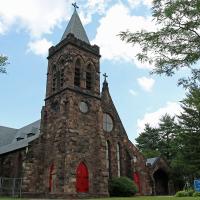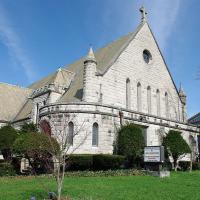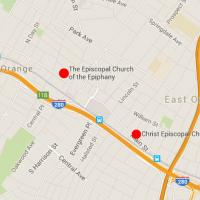
Beginning July 1 the Rev. Joseph Harmon, currently full-time Rector of Christ Church, East Orange, will divide his time between Christ Church and the nearby Church of the Epiphany in Orange where he will serve as Priest-in-Charge. The agreement, signed in May, extends for two years. Both churches are located on the same street and are only about three quarters of a mile apart, but the close proximity and the obvious budgetary advantages of sharing a clergy person account for only part of the story. More significant is the process that resulted in the decision to share a priest and the exciting benefits both churches expect to realize in addition to the cost savings.
“We actually began the conversation about sharing a clergy person in 2013,” explains Connie Horsley, Senior Warden at Christ Church. Horsley credits her predecessor, Senior Warden Bob Simmons, with getting things rolling. “Fr. Harmon asked Bob to take the initiative but from the very beginning there was great concern to keep members of both congregations fully informed at every step of the way.”
As a result, Horsley says, it took time to reach a final decision. A series of joint meetings of the vestries of each congregation were held, as well as joint church services. In 2014, in addition to shared Quiet Days and other community-building activities, the congregations held a joint Pentecost service at Epiphany and the following year celebrated a joint Easter Vigil service at Christ Church.
The meetings and worship services also offered Harmon opportunities to learn more about Epiphany and how the two congregations might share outreach efforts in addition to sharing clergy. Both churches, for instance, currently have ongoing food and clothing ministries.
Lorraine Jones, elected Senior Warden at Church of the Epiphany in 2013, agrees with her counterpart, Connie Horsley, about the emphasis on transparency during the negotiation process. “Everyone involved in the talks from the beginning realized this could be a way of easing the stress of operations for both churches and a way of putting our resources into the work of ministry,” she said. “But to gain truly widespread support among both congregations we were careful to keep everyone informed every step of the way. While there was naturally some hesitation on the part of a few members,” Jones recalls, “this was greatly allayed by the process of lengthy conversation and sharing.”
Bishop Mark Beckwith, Canon to the Ordinary Greg Jacobs, and diocesan CFO Paul Shackford were soon brought into the conversation to provide assistance and guidance, but both Horsley and Jones agree the impetus for exploring closer cooperation came from the churches themselves. Along the same lines Canon Jacobs recently observed, “We certainly want to encourage and support collaborative efforts toward shared ministry, but this is not a top-down process. How and when an expanded sharing of resources occurs is entirely up to these two churches. They happen to be in very close proximity, have similar outreach programs, and have many of the same challenges in maintaining two large and aging church structures.”
The proximity of the two congregations has a significant history. The property on which Christ Church in East Orange now stands was acquired in 1879, the congregation having been founded in 1868. As the country and the church moved forward with integration in the mid-twentieth century, Christ Church, while mostly white, moved with the changing times and early on began to have a mixed congregation of both black and white members. Church of the Epiphany, on the other hand, came to its present church building in 1986. Its history was described in a 2001 article in The Living Church written by the Rev. Dr. Ronnie T. Stout-Kopp, a priest of this diocese.
The article describes how in 1957 the former occupant of Epiphany’s present building, Grace Church, rather than moving ahead with integration, decided to found missions for “colored people” in the surrounding community. Then in the 1960s as racial demographics of the area began to change markedly, Grace Church proposed the idea of merger to the nearby, predominantly African-American, Church of the Epiphany. Given their painful history of exclusion, Epiphany’s members understandably decided to remain independent. “Epiphany thrived while Grace Church began to decline,” wrote Stout-Kopp.
Eventually, with its numbers seriously dwindling, Grace Church closed and the diocese invited Epiphany to take over the empty church building. Connie Horsley, Christ Church’s senior warden, has fond memories of worshipping in the original Epiphany building in the 1960s.
Currently the membership of both congregations is largely African-American, West Indian, Guyanese and Haitian, with some Latino members.
Harmon notes that the demographics of the two neighboring towns, while similar, still have important differences. East Orange has more Guyanese, West Indian and Haitian residents, while Orange has a growing Latino presence.
“As of now I’m semi-fluent in Spanish and am able to celebrate the Eucharist in that language,” says Harmon. “But I continue to work on my language skills and expect they will likely be a great help as I begin serving at Church of the Epiphany in Orange.”
Harmon says creatively engaging the local community will be a high priority as he assumes his new duties. He is gratified by the strong lay leadership in each church as this will enable to concentrate more on pastoral and liturgical ministry as well as teaching and community involvement.
Though he began his ministry at Christ Church in December 2011, since 1978 Harmon has led congregations in the dioceses of New Jersey, Albany, Michigan and Chicago. Most recently he served at Church of the Incarnation in Jersey City. This is not the first time he has been called upon to serve two congregations at the same time.
Having earned his bachelor of arts degree at Cornell University and his master of divinity degree at The General Theological Seminary, Harmon also earned his juris doctor degree from Widener University School of Law and remains an actively licensed attorney. In addition to his extensive experience in parish ministry, he has served as vice-president of the Garden State Episcopal Community Development Corporation.
“I’ll need to accommodate the somewhat different worship traditions in each congregation,” Harmon notes. “But a more important challenge will be to enable each congregation to identify their unique strengths and how they can be used collaboratively toward more effective outreach and ministry.”



